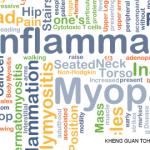Some work has been done to develop protocols for induction and maintenance treatments for patients with JDM, taking into account the main disease features (e.g., muscle involvement, skin involvement).2–4 However, Dr. Reed noted that individual treatment plans should be tailored to each patient’s disease manifestations and needs.
More studies are needed to define optimal treatments for patients with juvenile dermatomyositis. Ideally, these studies will include randomized controlled clinical trials.
Complications
Dr. Reed concluded by discussing several common complications of JDM and the medications used to treat the condition. Osteopenia and bone demineralization can arise from steroid use. However, they can also arise from inactivity due to weakness and from the inflammatory pathways involved in juvenile dermatomyositis that may increase osteoclastic activity.
Up to 40% of patients with JDM can have gastrointestinal (GI) involvement, such as GI vasculitis and perforation, pancreatitis, hepatitis and feeding issues. With respect to cutaneous issues, calcinosis can be a progressive and difficult-to-treat issue in many patients with JDM.
Jason Liebowitz, MD, completed his fellowship in rheumatology at Johns Hopkins University, Baltimore, where he also earned his medical degree. He is currently in practice with Skylands Medical Group, N.J.
References
- Rider LG, Nistala K. The juvenile idiopathic inflammatory myopathies: Pathogenesis, clinical and autoantibody phenotypes, and outcomes. J Intern Med. 2016 Jul;280(1):24–38. Epub 2016 Mar 30.
- Huber AM, Giannini EH, Bowyer SL, et al. Protocols for the initial treatment of moderately severe juvenile dermatomyositis: results of a Children’s Arthritis and Rheumatology Research Alliance Consensus Conference. Arthritis Care Res (Hoboken). 2010 Feb;62(2):219–225.
- Huber AM, Robinson AB, Reed AM, et al. Consensus treatments for moderate juvenile dermatomyositis: Beyond the first two months. Results of the second Childhood Arthritis and Rheumatology Research Alliance consensus conference. Arthritis Care Res (Hoboken). 2012 Apr;64(4):546–553.
- Bellutti Enders F, Bader-Meunier B, Baildam E, et al. Consensus-based recommendations for the management of juvenile dermatomyositis. Ann Rheum Dis. 2017 Feb;76(2):329–340. Epub 2016 Aug 11.
- Kim H, Gunter-Rahman F, McGrath JA, et al. Expression of interferon-regulated genes in juvenile dermatomyositis versus Mendelian autoinflammatory interferonopathies. Arthritis Res Ther. 2020 Apr 6;22(1):69.
- Campanilho-Marques R, Deakin CT, Simou S, et al. Retrospective analysis of infliximab and adalimumab treatment in a large cohort of juvenile dermatomyositis patients. Arthritis Res Ther. 2020 Apr 15;22(1):79.
- Deakin CT, Campanilho-Marques R, Simou S, et al. Efficacy and safety of cyclophosphamide treatment in severe juvenile dermatomyositis shown by marginal structural modeling. Arthritis Rheumatol. 2018 May;70(5):785–793. Epub 2018 Mar 25.


